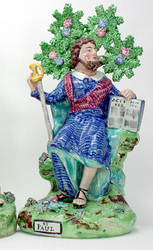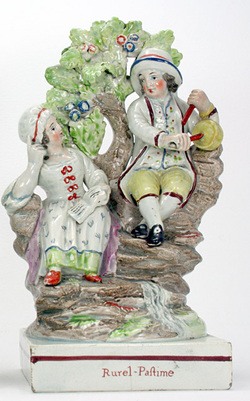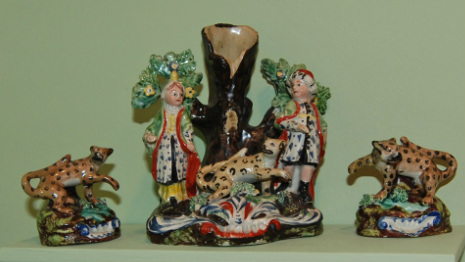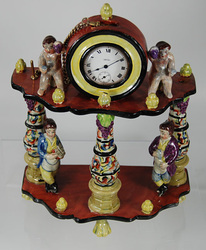|
I have had several emails asking about the Ralph Wood Spanish Musicians in the blog posting below. They were bought from John Howard. No surprise that John recognized their quality and rarity!
0 Comments
"You get what you pay for" goes the saying, and the more we pay, the more we apparently value our purchase. Look at overpriced fashion accessories: the price paid seemingly determines the 'value' placed on an otherwise junky item. Within my family, the same applies. I dole out PLENTY of excellent advice. My advice is totally free. It costs nothing. The result: it is valued at nothing! Nobody listens. And it goes without saying that I am ALWAYS right and never in doubt! Of course, nobody ever has to wonder what I am thinking, and that includes you, dear reader, for, like it or not, I give plenty of free advice. So it comes as no surprise that the many people who enjoy my blog don't follow my advice! That's just fine. I love you all anyway and thank you for simply hearing me out.....but let me assure you I follow the very advice I give you! Case in point: I jump up and down encouraging you to buy things in wonderful condition and to grab a marked piece. I am not saying buy a tired little thing that happens to have a mark. It goes without saying we don't buy purely for a mark. But when the piece is spiffy AND it has a mark....well, what are you waiting for? I didn't wait. I hopped right onto this pair of deer. This is a superb pair with only restoration to one ear. Those bocages are totally original. The glazes and enameling are great, and they are marked SALT. I checked my SALT page (as can you by going to the MAKERS tab at the top of this page.) I had not documented a true pair of Salt deer. This pair was a first. Interestingly, Salt only made female deer in this size. Both the left and right hand side of this pair are ladies, and my archive revealed that this is as it should be. Salt must have been a smart man. He just knew those antlers were destined to break. Or was Salt foreseeing the era of same sex marriages? Who knows. Anyway, I bought these for a very reasonable price from John Howard. John immediately pointed out the most endearing feature on the deers' coats. The painter painted the white spots by using his/her finger to remove the red-brown paint. As a result, each spot has a finger print smudged in red on it. Above all, I am very grateful to readers who listen to my needs enough to let me know when they have something special in their collections. It really does help my research enormously. When I immerse myself in a topic, it is amazing what I learn. Sometimes I genuinely feel that there is a Pottery God who rewards my efforts by tossing information my way. I have been lost in the world of Ralph Wood figures for months now. And, to my joy, this pair of figures came to light this month. These figures are very definitely attributable to Ralph Wood and were made circa 1790. About 210 years old! Is that not amazing? Look at the silky enamels, and the yummy, creamy color palette. And don't you love the way the glaze has puddled at the base of each figure?--you can really see this on the picture of the backs. To top it all, the figures are impressed 71 and 73. If this were not enough, there is more: I have only seen one enamel-painted Ralph Wood male Spanish Dancer. It was heavily restored and not numbered. Number 71 is a new addition to my ever-growing list of Ralph Wood enamel figure-number combinations. I have the female Spanish Dancer figure, unnumbered, twice. Now I have verification of a figure-number combination with this pair. Sweet, is it not? For any unfortunate soul reading this who actually prefers porcelain to pottery, here is some free advice. Have a look at the Derby porcelain figure of van Dunder currently on eBay ( item 260820821378) and compare it to the pottery figure made at the same time. I am sure the porcelain figure is probably just lovely...if you are a porcelain collector. But the pottery figure is SO much nicer. And remember, I am never wrong and never in doubt!!:)
If you want to read more about the Van Dunder figure, go to the FIGURES tab at the top of the page. Scroll quite far down and you will read all you could want to know about the greatest comic actor of the early 19th century. Fame is not fleeting if your image is captured in clay! The NEC Antiques Show is on in Birmingham and I long to be there. Someone sent me these pictures of John Howard's stand. For me they were a power shot, a boost of excitement that will push me through the day. I wish, wish, wish I could be there. If you are in driving distance, GO. I have heard from several collectors who report that it was a better than usual show, so don't miss out! A few years ago, I came across this figure. It is titled St. Paul and marked Walton. John Walton did indeed make a figure of St. Paul that looks like this figure, so what's wrong with this example? Well, the problem is the bocage. It is a bocage normally found only on figures we attribute to "Sherratt." Yes, "Sherratt" also made a figure of St. Paul with just this bocage....but the "Sherratt" St. Paul looks quite different. Can you see what I mean? On the left we have a Walton figure, on the right a "Sherratt" figure. (Click on the figures to enlarge.) Our problem figure blends the Walton figure form on the left with the bocage used by "Sherratt", as seen on the right. The restoration--if you can call it that--had been very well done. Unless you knew the bocage was wrong, you could be fooled. The join on the trunk was very well executed. Stripping the entire thing with paint stripper was perhaps the only way to know....unless you had done your homework and knew what bocage to expect on a figure marked "Walton." I have in the past few years seen two other figures that were marriages between a good figure and a good bocage--the problem in each case was that the bocage was not the correct one for the figure.Yes, the work had been very well done, so only knowledge of the correct bocage form for each figure protected collectors from falling into a trap. Again, paint stripper would have revealed the truth, but this is a pretty drastic step. I have watched collectors and dealers as I talk about bocages. Their eyes glaze over. But this is vital knowledge and we all need to tune in to it. Knowledge is power! I was browsing around the web today and discovered an old auction listing for a Rural Pastime figure. (Photos are the property of Auction By The Bay and are used here solely for educational purposes.) Pretty, isn't it? To my eyes, the figure was definitely made by Ralph Wood...but the bocage was not! The bocage is of the generic form used by many potters. Clearly it had been transplanted onto this figure to replace a lost or broken bocage. Removing a damaged bocage and replacing it with an intact one off another figure can be a lot easier than restoring correctly. In this case, it is easy to see that the bocage has been reattached because the join in the tree trunk is quite visible. Despite this, the figure sold at auction for $1000. The auction listing was quite upfront about the damage to the tree trunk and other damage. There was certainly enough information to set off alarm bells and a full condition report probably provided additional information. Remember that bocages do break off figures and they can be reattached. This is not a disaster scenario. I accept an original bocage being reattached. After all, all the original material is present and accounted for. But having the wrong bocage stuck on is a no-no. Below is the Rural Pastime figure as it should look, with its original bocage in place. As you look at the correct figure and compare it to our problem child, notice some other things. The girl should hold a book, not a flower. And the boy should have a stick in his hand, not a horn. How was this poor fella supposed to play two instruments simultaneously? An uninformed restorer improvises. A top restorer goes to infinite effort to restore correctly. I supply pictures to help restorers get it right, but alas one or two restorers routinely request this assistance. If you need a figure restored, make sure it is done correctly. Shout if you need help.
If you are burned out on watch holders, please hang in a while longer. I want you to see this watch holder, which, like John Howard's example (blogged last week) originates from Yorkshire. This watch holder is impressed with the mark of Dixon Austin & Co, a mark dating the piece to 1820-1826. The Dixon Austin pot bank is known for its lustre wares, but it also produced this particular watch holder in Pratt colors. Of course, pink luster is much prettier! Some of these watch holders have a finial atop, but this example was not made that way. There is a chip on the base, but that's it. The really beautiful lustring combined with vivid enamels makes this so eye catching. Now to the watch in the otherwise-gaping hole. This watch holder has a larger than normal opening--a full 2 inches, thus bigger than the size 18S watch that seems to be eBay's largest offering. A brilliant and very kind friend came to the rescue. He found a very old watch dial that was 2" across. I think dials this size date from the earlier decades of the 19th century. Anyway, the dial fits flush across the opening and looks just perfect. You can see the Dixon Austin & Co mark impressed on the front center of the base. Unusually in-your-face for a pottery mark, is it not? Notice the holes to either side of the mark. These, I believe, allowed you to screw the watch holder to a mantle. That way, it couldn't tip over. So if you find an antique surface with two holes in it just a little bit apart, you will know what once stood there! On a totally different topic: I am finicky about arranging my collection. Everything has to stand next to something that complements it. Lighting has to be perfect, and nothing is ever two-deep on my shelves. The one place where no rules apply is in my very utilitarian office. Three monitors face me for much of my day. No pottery? This was too harsh. So I stuck some shelves on the wall ahead of me, and pottery rotates on and off those shelves, with no thought to arrangement. Something new, something I am thinking about or writing about, or something I just want to look at...this is a great way to be always enjoying the thrill of my collection. The little leopards I bought from John Howard--blogged about last month--have arrived. Here they are, placed on one of those shelves, and on either side of the spill vase from the same pot bank. I have declared the chest in our entrance another 'rotational spot'. Each week, I put something different on it. My collection gives me endless pleasure, and I know yours must do the same for you.
In future, I will post to the blog every Tuesday. My every-fourth-day schedule is taking too much time, and I need to focus on the next publication. Meanwhile, there is three years of material in the old blog postings if you want to explore. You can access these under Archives on the right hand side of this page.
While we are on the subject of watch holders, I want to show you this one, which we may have visited in the past. I think it is particularly clever in the way it holds the chain that would have been attached to the watch. Note there is a hole to accomodate the T-pin at the end of the watch chain. Once the T-pin is in the hole, the watch is securely held in place. (Click each picture to enlarge). I suspect this watch holder is "Sherratt" but there really is nothing definitive to confirm my gut feeling. The two little men (one with sword, one with book) are tyler masons. They appear on either side of the Sherratt figure PREPARE TO MEET THY GOD. They also occur as individual figures, and all examples I have recorded are definitely "Sherratt". More on this another time. I love whacky figures and I find this watch holder somewhat weird. Brighton Museum has an example reminscent of this watch holder, but even weirder. I can't pretend it is a thing of beauty, but it is jaw droppingly odd. Would I buy this if I had the chance? Of course. It is fascinating. And with a watch in place, it would look so-o-o-o good.
If you haven't yet discovered the great pages about Staffordshire figures on Madelena's website, make time for them this weekend. This is the link . Don't miss the tabs at the top explaining value, restoration, repros and a host of other things. David and Ben Tulk, and those who help them at Madelena, really love Staffordshire and these pages are a fantastic learning tool. And after you have read them, go shopping on the site, www.madelena.com. Enjoy!
Did you notice this watch holder on John Howard's site? It really is quite wonderful and viewed from the side almost looks like a temple or shrine. To what? Why the watch of course! A proud owner would rest his watch--always a costly item in those days--in the opening. I wonder whether watches were left in permanently to serve as clocks. Of course we shall never know. Watch holders can be fascinating. I have several and have put an old watch in each. EBay is a good place for this type of purchase. You don't need a watch that works. I find most watch holders accommodate an 18S watch size--that is a bit under 2 inches. And the game is to get one for under $20! I wish I knew who made this temple-to-the-watch, but the enameling does look like much of the work that came out of the Staffordshire Potteries. In my archive I have a watch holder, apparently from the same molds. It sold at Woolley & Wallis. This watch holder is marked FELL, the mark used by Thomas Fell of Newcastle from 1817. When I think 'Newcastle' I think 'lustre' and both these watch holders have pink lustre decoration. Fell focused on undecorated and enamel decorated wares, rather than lustre, and these watch holders meld enamels and lustre deliciously. I don't know whether Woolley & Wallis's example once had a lion, but its relationship to John Howard's watch holder convinces me that John's gem was also made by Fell.
I must admit to being astounded by the new items John continues to get into stock--and move out of stock. I don't know when in my collecting 'career'--which now spans over three decades--I have seen any dealer turn over such a fantastic selection of figures at a steady pace. And that includes the stock of the now legendary Jonathan Horne and Alistair Sampson. I am so happy that the market for fabulous pottery continues to thrive...and I am doing my share of helping it along! |
Archives
February 2024
All material on this website is protected by copyright law. You may link to this site from your site, but please contact Myrna if you wish to reproduce any of this material elsewhere. |




























